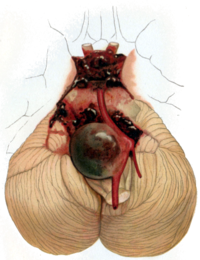
Photo from wikipedia
OBJECTIVE Smoking is a known risk factor for aneurysm development and aneurysmal subarachnoid hemorrhage, as well as subsequent vasospasm in both untreated individuals and patients who have undergone surgical clipping… Click to show full abstract
OBJECTIVE Smoking is a known risk factor for aneurysm development and aneurysmal subarachnoid hemorrhage, as well as subsequent vasospasm in both untreated individuals and patients who have undergone surgical clipping of cerebrovascular aneurysms. However, there is a lack of data in the current scientific literature about the long-term effects that smoking has on the integrity of endovascular repairs of cerebral aneurysms. This study was designed to determine if any smoking history increased the risk of poorer outcomes and/or aneurysm recurrence in patients who have had endovascular repair of cerebral aneurysms. METHODS The authors retrospectively analyzed the medical records of patients admitted to the University of Michigan Health System from January 1999 to December 2011 with coiled aneurysms and angiography, CT angiography, or MR angiography follow-up. Patients were identified and organized based on many criteria including age, sex, smoking history, aneurysm recurrence, aneurysm location, and Hunt and Hess grade. Analysis was targeted to the patient population with a history of smoking. Bivariate chi-square tests were used to analyze the association between a positive smoking history and documented aneurysm recurrence and were adjusted for potential confounders by fitting multivariate logistic regression models of recurrence. RESULTS A total of 247 patients who had undergone endovascular treatment of 296 documented cerebral aneurysms were included in this study. The recurrence rate among all patients treated with endovascular repair was 24.3%, and the average time to the most recent follow-up imaging studies was 1.62 years. Smokers accounted for 232 aneurysms and were followed up for an average of 1.57 years, with a recurrence rate of 26.3%. Never smokers accounted for the remaining 64 aneurysms and were followed up for an average of 1.82 years, with a recurrence rate of 17.2%. Multivariate analysis revealed that, after controlling for potential confounders, a history of smoking-whether current or former-was associated with a significantly increased risk of aneurysm recurrence. The odds ratios for aneurysm recurrence for current and former smokers were 2.739 (95% CI 1.127-7.095, p = 0.0308) and 2.698 (95% CI 1.078-7.212, p = 0.0395), respectively, compared with never smokers. CONCLUSIONS A positive smoking history is associated with a significantly increased risk of aneurysm recurrence in patients who have undergone endovascular repair of a cerebral aneurysm, compared with the risk in patients who have never smoked.
Journal Title: Journal of neurosurgery
Year Published: 2018
Link to full text (if available)
Share on Social Media: Sign Up to like & get
recommendations!